A Profile of Frontline Workers in the Bay Area
Our analysis of the Bay Area's essential workforce reveals how the workers on the frontlines of the pandemic are disproportionately low-income, Latinx, Black, Filipinx, women of color, and immigrants and face economic and social vulnerabilities.
By Jamila Henderson, Eliza McCullough, and Sarah Treuhaft
The COVID-19 crisis is shining a spotlight on inequities throughout our society and economy, including the divide between knowledge economy workers who can safely shelter in place and work-from-home and frontline “essential” workers, predominantly people of color, whose work interacting with the public puts them at greater risk of contracting the virus. This divide is particularly gaping in the Bay Area, with our stark inequality and tech-driven economy. Grocery store clerks, bus drivers, janitors, and other frontline workers perform work that we depend on for our daily lives, yet they often are paid low wages, lack sick days and health insurance, and lack full workers’ rights. On May 1, workers at Instacart, Whole Foods, McDonalds, and other companies went on strike demanding proper protective equipment and fair wages.
A new study based on extensive community testing in the Mission District, which has the most coronavirus cases among all San Francisco neighborhoods, provides data underscoring the very real risks faced by essential workers: 90 percent of residents who tested positive for the virus cannot work from home, 95 percent are Latinx, and 82 percent said they have been financially affected by the pandemic. Early data from Santa Clara County also shows that Latinx and Black residents are dying from the virus at higher rates than other groups. The virus is exploiting and deepening existing inequities by race, class, and geography that were produced through explicitly and implicitly racist policies and business practices – ultimately exacerbating regional inequality.
Knowing who is vulnerable is crucial for developing solutions. This analysis, based on data from the 2014-2018 American Community Survey provided by the Center for Economic and Policy Research, describes the characteristics of essential workers in the nine-county Bay Area and describes actions that employers and policymakers can take to ensure their health and economic security. Find our full methodology below and download the data tables for the analysis – including data for each of the nine Bay Area counties – here. Read our county level analyses, including our posts for Sonoma County and Santa Clara County, and stay tuned for future Bay Area county analyses.
There are 1.1 million essential workers in the region — about 28 percent of all workers — spread across 11 industries. These workers include doctors and nurses on the frontlines of the health crisis as well as the workers taking care of their children. They also include the farm and factory workers who produce our food and other household goods, and the cashiers, postal workers, and warehouse workers who ensure we can get them. Other essential workers are the janitors, housekeepers, and waste management workers that keep our facilities, residences, and communities clean, and the bus drivers that allow other essential workers to reach their jobs.
Workers of color are overrepresented in frontline industries overall, representing 58 percent of all workers but 66 percent of essential workers. Latinx workers represent 22 percent of workers in all industries but 31 percent of frontline workers. Latinx workers are particularly overrepresented in building cleaning/waste management and agriculture, accounting for about two-thirds of workers in each industry. Latinx workers are similarly overrepresented among domestic workers and construction occupations, accounting for half of all workers in these industries.
Black workers, who account for just 5 percent of all workers in the region, are also concentrated in specific frontline industries including public transit (23 percent); trucking, warehouse, and postal services (11 percent); childcare and social services (10 percent); and health care (8 percent).
Although not overrepresented among frontline industries as a whole, Asian and Pacific Islander (API) workers, who account for more than a quarter (27 percent) of workers overall, are overrepresented in frontline industries including health care (36 percent); manufacturing (32 percent); and trucking, warehouse, and postal service industries (32 percent). Immigrant workers also make up a disproportionate share of essential workers (43 percent) compared with 37 percent across all industries.
Women of color are most likely to be concentrated in essential industries (33 percent share of essential industries versus 27 percent share of industries overall). Men of color are also slightly more likely to work in essential industries (33 percent share in essential industries versus 31 percent of industries overall). Women of color disproportionately work in the following essential industries: domestic work (66 percent); childcare (54 percent); health care (47 percent); and building cleaning services/waste management (42 percent). Latina workers make up one- tenth of the labor force, but nearly half of all domestic workers (47 percent), 37 percent of building cleaning services/waste management workers, and 23 percent of childcare and social services workers. API women account for 13 percent of the labor force, but one-quarter of workers in the health-care industry and about one-fifth in the childcare and social services industry (21 percent). Black women, who make up 3 percent of all workers, are overrepresented in the public transit (11 percent), childcare and social services (8 percent), and health care (6 percent) industries. Among male workers, Latinos, who make up 13 percent of all workers, are overrepresented in essential industries of construction (52 percent); agriculture (49 percent); building cleaning services/waste management (30 percent); and trucking, warehouse, and postal service (26 percent).
Chinese workers make up the largest share of Asian workers (33 percent), and although they are not overrepresented across all frontline industries, they account for over half (53 percent) of Asian workers in construction and are also overrepresented in utilities, childcare and social services, agriculture, and building cleaning/waste management. Filipinx workers account for 22 percent of all Asian workers, 35 percent of all Asian workers in frontline industries, and 47 percent of Asian health-care workers. Many Filipinx nurses trained in American nursing programs in the Philippines, a relic of US colonial rule in the country, and filled a growing need for nurses in the United States following WWII.
Other Asian workers are not overrepresented in frontline industries overall, but are concentrated within specific industries. Vietnamese workers, for example, make up one-tenth of all Asian workers yet 15 percent of Asian construction workers and 13 percent of Asian manufacturing workers. Japanese workers account for 4 percent of all Asian workers, but 15 percent of Asian workers in the agricultural industry. Indian workers make up one-fifth of all Asian workers but are not concentrated in frontline industries (and therefore are not included in the chart above).
Frontline workers have more economic and social vulnerabilities than workers overall. They are more likely to live in poverty, rent rather than own their homes, pay too much for housing, have limited English, lack US citizenship, be caring for children and/or seniors at home, and lack internet access. Nearly 17 percent of all frontline workers live below 200 percent of the poverty level (about $48,000 for a family of four) compared to 13 percent of all workers. Frontline workers earn less (median earnings of $57,989 versus $70,917 for all industries) and are less likely to hold a college degree, and more likely to lack health insurance.
Frontline workers are more likely to lack health insurance (8 percent) compared with workers overall (6 percent), but even more stark are the uninsured rates within particular frontline industries. Workers that are particularly vulnerable include those in the agriculture; domestic worker; construction; and building cleaning services/waste management industries, where the uninsured rates surpass 15 percent. Frontline industry workers face other challenges that also put their health at risk, including a lack of sick days and the inability to advocate for their rights as workers without retribution.
Frontline Workers Need Our Support
Essential workers put their health on the line every shift to provide for our community’s basic needs — and we must do everything possible to minimize their health risks and ensure their financial stability and long-term success. For frontline workers to be healthy and economically secure they need proper protective gear and testing, paid sick leave and affordable health care, living wages, childcare and elder care, and secure housing.
Employers and the federal government should be doing much more to provide these essentials, but given insufficient action, Bay Area cities have implemented multiple policies to improve conditions, including free coronavirus testing sites, free and reduced-price childcare, and expanded mental health services. While these policies provide a good starting point, we must dramatically expand protections for frontline workers at the municipal, state, and federal level to ensure that they are healthy and safe throughout the duration of this crisis and beyond.
Employers and state and local government should take the following actions to support frontline workers and provide for the common good.
Employers must ensure safe working conditions, paid sick leave, living wages, and a voice at work. Employers should take all possible steps to prevent employee exposure to COVID-19, including provision of masks and gloves, frequent hand-washing breaks, and routine surface cleaning. Employers should also offer paid sick leave for all workers, including contractors. (Businesses with more than 500 employees are not required to provide paid sick leave under the federal Emergency Paid Sick Leave Act.) Small and mid-sized businesses must allow employees to stay home if exposed to COVID-19 or if they or a loved one is sick. Employers should provide hazard pay to account for the danger involved in working during this pandemic, and should be paying frontline workers a living wage at all times. The Insight Center’s Family Budget Calculator shows that in Alameda county, a family of four with an infant and a child in elementary school needs about $105,000 to cover basic household expenses: a $24.74 hourly wage for both working parents. Lastly, workers should be able to voice their concerns about working conditions and negotiate for better pay, benefits, and conditions without retribution.
Local governments should expand paid sick leave, increase access to free testing and affordable treatment, and cancel rent, mortgage, and utility payments. First, they should require paid sick leave for employers of all sizes. Berkeley, Emeryville, and San Francisco had paid sick leave policies prior to the outbreak, and San Jose passed an emergency paid leave ordinance covering large employers and gig workers that are not covered by the federal Emergency Paid Sick Leave Act, including gig workers in early April. San Francisco extended its ordinance to allow employees to care for sick relatives and cover gig workers. Oakland City Councilwoman Sheng Thao has also called for an expanded emergency paid sick leave ordinance. Local governments should also provide free testing and ensure access to affordable treatment for those infected with COVID-19. Finally, local governments should ensure everyone, including frontline workers, has access to safe housing. Although more than a dozen Bay Area cities have passed emergency tenant protections, such as suspending evictions and late fees for those affected by COVID-19, and several San Francisco supervisors have proposed rent cancellation, no jurisdiction has canceled rent, mortgage, or utilities payments. The San Francisco Board of Supervisors also recently announced that the city will secure 8,250 hotel rooms for frontline workers, those experiencing homelessness, and other vulnerable groups. Bay Area cities should replicate and expand upon these actions to ensure everyone has housing.
The state has a key role to play in protecting workers in the Bay Area and beyond by expanding access to paid sick leave, testing and treatment, and housing; and suspending rent and mortgage payments for workers impacted by COVID-19. First, California must expand access to Medi-Cal as multiple news reports have found that coronavirus testing and treatment can cost as much as $35,000 for uninsured patients. In March, the state waived all cost-sharing for COVID-19 testing and facilitated Medi-Cal enrollment for those seeking testing and treatment. California should allow all undocumented residents to access comprehensive Medi-Cal coverage. Next, the governor should expand Executive Order N-51-20, which requires food sector employers with 500 or more employees to provide paid sick leave, to cover employers of all sizes and include other frontline industries such as transportation. California must also strengthen tenant protection policies and fund housing initiatives to ensure all frontline workers have a home. While the state enacted a statewide moratorium on evicting renters impacted by COVID-19, rent and mortgage payments should also be suspended. Governor Newsom recently announced a program that will provide frontline health-care workers with hotel rooms close to hospitals. This program should be expanded to provide housing for all frontline workers who need housing. Finally, California should enact the Essential Workers’ Bill of Rights put forward by the California Labor Federation, which includes demands such as protecting and expanding the right to form a union and ending ICE raids, deportations, and other attacks against our immigrant communities.
Methodology
The data for this analysis was provided by the Center for Economic and Policy Research (CEPR) which produced an analysis of frontline workers at the national and state level. We use a similar methodology described below.
This analysis of frontline workers (16 years and older) in the Bay Area includes 11 frontline industry categories, but no workers in frontline occupations that are outside of these 11 categories. As a result, estimates exclude some workers in occupations (but not industries) that are clearly on the frontlines, while also including some workers who are not in frontline occupations, even though they are in frontline industries. For example, a police officer is a frontline occupation, but this occupation does not fall within the 11 frontline industries. A school bus driver on the other hand, is not a frontline occupation given school closures, but it falls within a frontline industry (public transit). Still, most workers in the 11 frontline industry categories are frontline workers.
The Bay Area analysis includes the six industries included in CEPR’s analysis (health care; grocery, convenience, and drug stores; childcare and social services; building cleaning services; trucking, warehouse, and postal service; and public transit) plus the following industries prioritized by our Equity Campaign Leaders Advisory Committee and the Equity Working Group of ReWork the Bay: waste management; agriculture, forestry and fishing; select manufacturing sub industries; utilities; domestic workers (excluding health care); and occupations within the construction industry. The specific industries or occupations within each industry group include:
- Health Care: Offices of physicians; outpatient care centers; home health-care services; other health-care services; general medical and surgical hospitals, and specialty (except psychiatric and substance abuse) hospitals; psychiatric and substance abuse hospitals; nursing care facilities (skilled nursing facilities); residential care facilities, except skilled nursing facilities.
- Construction: Occupations within the construction industry, including construction trades (e.g., electricians, painters) and laborers.
- Manufacturing: Food and agricultural manufacturing; medical supply manufacturing; other critical manufacturing (e.g., commercial and service industry machinery).
- Grocery, Convenience, and Drug Stores: Grocery and related product merchant wholesalers; supermarkets and other grocery stores; convenience stores; pharmacies and drug stores; and general merchandise stores, including warehouse clubs and supercenters.
- Childcare and Social Services: Individual and family services; community food and housing, and emergency services; and child day care services.
- Building Cleaning Services and Waste Management: Cleaning services to buildings and dwellings (except for construction); and waste management and remediation services.
- Trucking, Warehouse, and Postal Service: Truck transportation; warehousing and storage; and postal service.
- Domestic Workers (not including health care): Private households.
- Agriculture, Forestry, and Fishing: Crop production; animal production and aquaculture; forestry except logging; logging; fishing, hunting and trapping; support activities for agriculture and forestry.
- Utilities: Electric power generation, transmission, and distribution; natural gas distribution; electric and gas, and other combinations; water, steam, air conditioning, and irrigation systems; sewage treatment facilities; not specified utilities.
- Public Transit: Rail transportation; and bus service and urban transit.
Racial/ethnic categories include Hispanic/Latino of any race; the following non-Hispanic, single race categories: White; Black/African American; and Asian American or Pacific Islander. The “Other” category includes populations too small to report individually (i.e., Native American or Alaska Native; two or more races; and those who identify as another single race not included above). Because the Asian American and Pacific Islander population in the Bay Area is very diverse, we include disaggregated data for the largest Asian American and Pacific Islander ancestries in the Bay Area (which are all “Asian” ancestries; Pacific Islanders, a small share, are excluded from the disaggregated Asian ancestry analysis).


